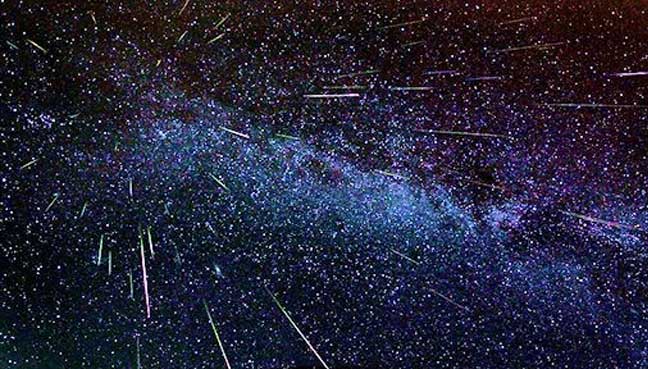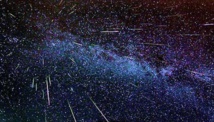You do not even need a telescope or special, geeky glasses.
At its peak, up to 100 shooting stars per hour will streak across the sky -- more than one a minute.
Viewing is expected to be even easier this year because the moon's glow won't interfere with meteor-watching, as it will be approaching its darkest or "new" phase, experts say.
The light show will be visible around the globe, but especially bright in northern latitudes above the United States, Europe and East Asia.
What we often call "falling stars" are actually tiny bits of space rock that smash into the atmosphere at about 60 kilometres (37 miles) per second, burning up in flashes of light.
Occasionally, longer and brighter streaks are seen, from pea- or marble-sized comet remnants.
The flaming nuggets visible over the next couple of days are from the tail of the Swift-Tuttle comet, which swings around the solar system every 130 years or so.
"All comets probably have a bad case of dandruff," said Carolin Crawford, the public astronomer at the University of Cambridge's Institute of Astronomy.
"But this one is one where the Earth's orbit takes it smack through the centre of the trail of debris that it leaves behind."
Swift-Tuttle last crossed paths with Earth's orbit in 1992.
The visual intensity of the meteor shower is caused not only by the number of space pebbles streaking into the atmosphere but also by the angle at which we approach them.
"It's like driving through a snow storm," said Jackie Faherty, an astronomer at the American Museum of Natural History.
"A meteor shower is a collision between the Earth" -- whipping through Space -- "and this debris tail," she explained.
"We are not hitting one little spot, but turning through it. As in a snow storm, when you are in the front of a car it looks way worse than when you are at the back."
Amateur interest around the globe is high, but astronomy shops in London were not exactly buzzing with talk of the meteor shower Wednesday.
"It's not something we spend a great amount of time chatting to people about," said someone from The Widescreen Centre, an astronomy supplies store.
"Meteor showers are best seen with the unaided eye and we can't sell people equipment to do that."
The showers are named after the constellation of Perseus, the hero from Greek mythology who beheaded the snake-headed Medusa to save the princess Andromeda.
"It's going to be a spectacular show this year," astronomer Morgan Hollis of the Royal Astronomical Society told AFP previously. "You'll be able to a see a lot more than normal."
-----------------------------------------------------------------------------------------------------------------------------
At its peak, up to 100 shooting stars per hour will streak across the sky -- more than one a minute.
Viewing is expected to be even easier this year because the moon's glow won't interfere with meteor-watching, as it will be approaching its darkest or "new" phase, experts say.
The light show will be visible around the globe, but especially bright in northern latitudes above the United States, Europe and East Asia.
What we often call "falling stars" are actually tiny bits of space rock that smash into the atmosphere at about 60 kilometres (37 miles) per second, burning up in flashes of light.
Occasionally, longer and brighter streaks are seen, from pea- or marble-sized comet remnants.
The flaming nuggets visible over the next couple of days are from the tail of the Swift-Tuttle comet, which swings around the solar system every 130 years or so.
"All comets probably have a bad case of dandruff," said Carolin Crawford, the public astronomer at the University of Cambridge's Institute of Astronomy.
"But this one is one where the Earth's orbit takes it smack through the centre of the trail of debris that it leaves behind."
Swift-Tuttle last crossed paths with Earth's orbit in 1992.
The visual intensity of the meteor shower is caused not only by the number of space pebbles streaking into the atmosphere but also by the angle at which we approach them.
"It's like driving through a snow storm," said Jackie Faherty, an astronomer at the American Museum of Natural History.
"A meteor shower is a collision between the Earth" -- whipping through Space -- "and this debris tail," she explained.
"We are not hitting one little spot, but turning through it. As in a snow storm, when you are in the front of a car it looks way worse than when you are at the back."
Amateur interest around the globe is high, but astronomy shops in London were not exactly buzzing with talk of the meteor shower Wednesday.
"It's not something we spend a great amount of time chatting to people about," said someone from The Widescreen Centre, an astronomy supplies store.
"Meteor showers are best seen with the unaided eye and we can't sell people equipment to do that."
The showers are named after the constellation of Perseus, the hero from Greek mythology who beheaded the snake-headed Medusa to save the princess Andromeda.
"It's going to be a spectacular show this year," astronomer Morgan Hollis of the Royal Astronomical Society told AFP previously. "You'll be able to a see a lot more than normal."
-----------------------------------------------------------------------------------------------------------------------------









 Home
Home Politics
Politics











